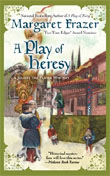CHAPTER 19
They parted at the corner of Much Park Street and Earl Street, Burbage saying he would be glad to get back to his proper work, Master Waldeve muttering glumly that he might as well find out a new rope before he did anything else. Joliffe said nothing but plain farewell to them both. Since Master Waldeve went rightward and Burbage cut slantwise across the street toward his own Bayley Lane, Joliffe went left. What he needed to do now was find Sebastian. Or let Sebastian find him…
Often in my books I often cannot explore aspects of medieval life in as much detail as I enjoy. For the sake of the story, much has to be left out. As someone wisely said, 90% (or was it 95%?) of what an author researches does not show up in the finished work.
To the good, that large, unused portion of research usually informs what is there, and without it the finished work would be far poorer. Thus, in readying for A Play of Heresy I read Alexander Murray’s Suicide in the Middle Ages1, to add to what other information I gathered from other sources, and yet very little of Murray’s compendious scholarship made it overtly into the novel. (I should add, by the way, that rather than being as depressing as I feared Murray’s work might be, it was quite humane and fascinating.) One thing I brought away was how relatively sympathetically the suicide was treated in medieval England. On the continent, the usual practice seems to have been to drag the dead body publicly from the site of death through the streets to somewhere outside the town or village, for it then to be thrown into a ditch or river or onto waste land, to rot as it would. In England, there was no such traumatic treatment of the body, and while there was no possibility of burial in consecrated ground, the suicide having damned their soul beyond salvation, burial was allowed in unconsecrated ground without exposure of the body to elements and animals.
Still, the psychology underlying the medieval view of suicide is intriguing, giving insight as it does into a world view unfamiliar to many of us now. Suicide and attempted suicide were believed to be caused by melancholy — depression, in modern terms – which “was a particularly noxious complaint” in the Church’s eyes, based on St. Augustine, “since the melancholic’s despair suggested that he was not suffused with joy at the certain knowledge of God’s divine love and mercy”, making the melancholic someone “turning away from all that was holy.”2
Worse, deep melancholy was thought to be caused by the possession of a demon, “since in order to control the victim’s soul the Devil creates the delusions and melancholy which often precede such an attempt” at suicide.3 Exorcism sometimes helped, but sometimes it did not and the devil won, and because the victim succeeded in killing himself while his soul was possessed by a devil, he could be considered nothing else except damned. That must, inevitably, have added another layer of sorrow to the survivors’ grief, but gives us an insight to a world view no longer predominant in Western culture.
Interestingly, while madness was a recognized defense in medieval English courts (with the rider to be watchful for people faking it), such exculpatory madness was never attributed to the Devil except in the case of suicides, so deep did the conviction run that only someone utterly damned would kill themselves.
As a pedantic aside, no one of course could commit “suicide” in medieval England: The word “suicide” did not come into use until the 1700s. Before then, the killing of one’s self was termed “self-murder” (which, by the way, in Latin is suicide) and so I call it that throughout Heresy.
– Margaret
Sources
1 Murray, Alexander. Suicide in the Middle Ages. Oxford University Press, USA.
2 Solomon, Andrew. The Noonday Demon. p.292.
3 Goodich, Michael, editor. Other Middle Ages. University of Pennsylvania Press, 1998. p.154.
Follow the virtual bookclub for A Play of Heresy on Facebook and Twitter.
















